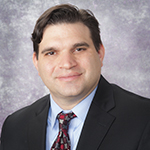
If you follow transplant news, you probably know the grim facts: Worldwide, there is an enormous and widening gap between the number of people who need transplant organs and the number of donor organs available. According to the United Network for Organ Sharing (UNOS), 20 people die every day waiting for a transplant. While UNOS and other organizations work to increase awareness and recruit more donors, researchers and doctors are working hard to find medical solutions that can help close that gap.
One of these researchers is McGowan Institute for Regenerative Medicine affiliated faculty member and UPMC heart transplant surgeon Christopher Sciortino, MD, PhD. He has a frontline view of the donor gap, and a passionate vision of the lives that can be saved when that gap narrows, the pool expands, and transplants take place earlier when patients have a better chance for a healthy life.
That’s why Dr. Sciortino, Assistant Professor of Cardiothoracic Surgery at the University of Pittsburgh School of Medicine and Surgical Director of the UPMC Advanced Heart Failure Center, is leading a clinical trial at UPMC that is pushing the donor envelope. The new source of hearts is one that you might not expect: donors who test positive for hepatitis C.
Hep C: Not the Threat It Once Was
Most people know hep C is a serious blood-borne viral disease that can cause liver damage, liver cancer, and death. It is transmitted through IV drug use, tattooing, and other ways that blood can pass from one person to another — including through transplants.
Although the risk of infection is only around 1 percent, until recently organs from hep C-antibody positive donors were excluded from the transplant pool. But that picture has changed for the better with the development of new antiviral hep C drugs offering a 95 percent cure rate and that are much better tolerated by immunosuppressed transplant recipients. Progressive hospitals such as UPMC, with its long history of pioneering transplant research, are leading the way in using this breakthrough to access a larger pool of donor organs, beginning with hearts.
Emphasis on Safety
Last year, under Dr. Sciortino’s leadership, UPMC embarked on a conservative, safety-focused protocol for hep C-antibody positive heart transplants. Initial criteria excluded high-risk recipients, such as dialysis patients, who are likely to suffer complications. In addition, donor organs were restricted to a four-hour maximum travel distance. “We wanted to demonstrate a foundation of safety for the process before opening it up to everyone,” says Dr. Sciortino.
The protocol has resulted in a handful of transplants over the past year — all successful operations. With these promising results, UPMC expanded its criteria to accept higher risk patients and hearts from farther away. In addition to hearts, the program now accepts kidneys, lungs, and even livers from hep C positive donors. The donor pool, which had initially been restricted to organs from donors with hep C antibodies but no disease, now includes organs from hep C positive donors.
A Natural Fit
New developments like this aren’t going to close the transplant gap any time soon, but a mainstream protocol for hep C hearts is a promising step. And it’s a natural fit for UPMC, where organ transplantation first made great strides through the pioneering research of Thomas E. Starzl, MD, in the 1980s. Today, UPMC is one of only a handful of hospitals with the resources and experience to perform hep C organ transplants. “We are a progressive center,” says Dr. Sciortino. “We don’t want to have to say to someone who needs a transplant, ‘you’re too sick for us to help you.’ Built on a foundation of safety, our approach allows us to partner with patients with challenging conditions. That’s what this work is all about.”
Read more…
